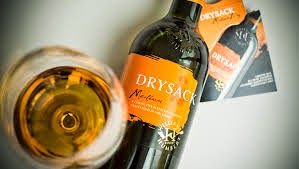Delving more and more into the back story of wine I find it very interesting how our modern day experiences differ from past eras. Say you had to pick just one wine to serve at a function or get together, you'd probably go with a dry red table wine; pleasantly tasty but not too rich or fruity. A Cote du Rhone or Montepulciano d'Abruzzo.
Remarkably, for a lot wine history, this is precisely what no one would have expected. Instead, sweetish, sometimes fortified, white wine has held long periods of sway. I was surprised to find that Falernian, the premium Italian wine of the Ancient Roman aristocracy was in fact a richly aged sweet wine most akin to modern day madeira, rather than a juicy, tannic red that the mezzogiorno can produce so competently today.
While I profiled the popularity of claret in Britain last week, sweet German white wine from the Rhine Valley was also quite a popular import from the medieval period onward. The problem it shared with the earlier, lighter style of Bordeaux claret was that it didn't keep. Coopering technology wasn't airtight, so to speak, and so a consumer of wine was always looking for the freshest potation possible.
One style of wine that was easier to keep was higher alcohol sweet whites that tended to be produced in and around the Greek islands. Not only was this a long way to ship wine to England, but by the dawn of the age of exploration that part of the Mediterranean was under Ottoman dominion.
Up stepped the entrepreneurial Spanish Duke of Medina Sidonia. At the port of Saluncar, down river from Seville, he got rid of any export duty on local wines, and encouraged English merchants to establish premises in the town during the halcyon early days of Henry VIII's marriage to Catherine of Aragon. This wine, from the southern extremity of Christian Andalucia was known in Spanish specifically as an export item, or saco. The English rendered it as sack. Later generations, perhaps in an early bout of wine pontificating, attempted to pronounce Jerez, the prominent town of the nearby vineyards, and came up with sherry.
 |
| A view of Jerez de la Frontera; sherry and 'Uncle Pepe' feature prominently |
One incredible episode in particular led to a sherry rage in England. In 1587, the well known circumnavigator and pirate Francis Drake decided to add to his legend by mounting a preemptive raid on Cadiz, the staging point for the Spanish Armada. Sailing with a fleet unmolested into the harbour full of ships stuck inertly at anchor. The raid was so daring, that not only did Drake abscond with four galleons laden with gold and arms, but had the time to make off with nearly 1,500 tuns of sack that had been sitting on the quayside.
It was said there was hardly a tavern in England that for years to come didn't advertise 'authentic Cadiz' among their stocks.
Not far from where a replica of Drake's Golden Hinde lies moored on Bankside is the recreation of the Globe Theatre, and the neighborhood still sports a handful of taverns in the same location as those of Drake and Shakespeare's day. In the spirit of the age, not surprisingly sack was one of his drinks of choice, most notably commemorated in the inebriated knight Falstaff in Henry V. This steady habit culminates in his humourous paean where he opines that "If had a thousand sons, the first humane principle I would teach them should be, to forswear thin potations, and to addict themselves to sack".
Hugh Johnson notes that by 'thin potations', Falstaff is of course referring to the other predominant choices, Gascon claret or Rhenish white. However, sack wasn't fortified with spirits in those days, and thus hit a natural maximum alcohol of around 16%. It's probably a good thing he never had the chance to come across Vintage Port.
In modern times 'sack' is still given as a byword for medium dry sherries, like oloroso or amontillado. Indeed Williams & Humbert, one of the old English sherry houses, still label their amontillado as 'Dry Sack'; and this inviting and affordable drop served, slightly chilled, as many an aperitif for me in university days. We're reminded that unlike the polite one or two glasses before a meal that was drunk in the 19th and 20th centuries, prior to that our London Bankside revelers would have been on the higher proof sherry all night. But, best leave my encounters with casks of amontillado in Thames-side cellars for another time.
 |
| Williams & Humbert Dry Sack, still delicious |


No comments:
Post a Comment